TOYOTA PRIUS C 2017 NHP10 / 1.G Owners Manual
Manufacturer: TOYOTA, Model Year: 2017, Model line: PRIUS C, Model: TOYOTA PRIUS C 2017 NHP10 / 1.GPages: 596, PDF Size: 10.05 MB
Page 421 of 596
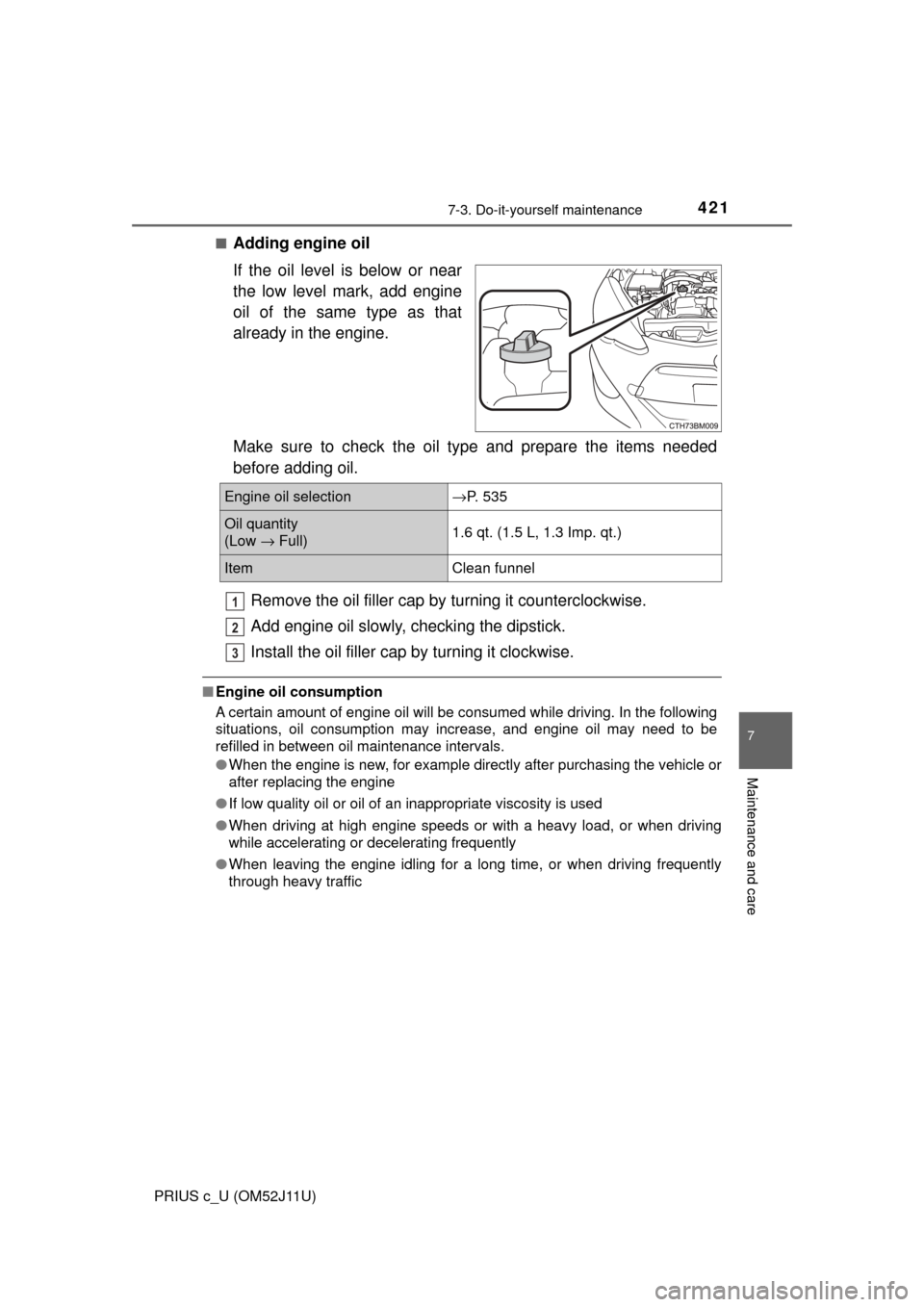
4217-3. Do-it-yourself maintenance
7
Maintenance and care
PRIUS c_U (OM52J11U)■
Adding engine oil
If the oil level is below or near
the low level mark, add engine
oil of the same type as that
already in the engine.
Make sure to check the oil type and prepare the items needed
before adding oil.
Remove the oil filler cap by turning it counterclockwise.
Add engine oil slowly, c hecking the dipstick.
Install the oil filler cap by turning it clockwise.
■Engine oil consumption
A certain amount of engine oil will be consumed while driving. In the following
situations, oil consumption may increase, and engine oil may need to be
refilled in between oil maintenance intervals.
●When the engine is new, for example directly after purchasing the vehicle or
after replacing the engine
● If low quality oil or oil of an inappropriate viscosity is used
● When driving at high engine speeds or with a heavy load, or when driving
while accelerating or decelerating frequently
● When leaving the engine idling for a long time, or when driving frequently
through heavy traffic
Engine oil selection →P. 535
Oil quantity
(Low → Full) 1.6 qt. (1.5 L, 1.3 Imp. qt.)
Item
Clean funnel
1
2
3
Page 422 of 596

4227-3. Do-it-yourself maintenance
PRIUS c_U (OM52J11U)
WARNING
■Used engine oil
● Used engine oil contains potentially harmful contaminants which may
cause skin disorders such as inflammation and skin cancer, so care
should be taken to avoid prolonged and repeated contact. To remove used
engine oil from your skin, wash thoroughly with soap and water.
● Dispose of used oil and filters only in a safe and acceptable manner. Do
not dispose of used oil and filters in household trash, in sewers or onto the
ground. Call your Toyota dealer, service station or auto parts store for
information concerning recycling or disposal.
● Do not leave used engine oil within the reach of children.
NOTICE
■To prevent serious engine damage
Check the oil level on a regular basis.
■ When replacing the engine oil
● Be careful not to spill engine oil on the vehicle components.
● Avoid overfilling, or the engine could be damaged.
● Check the oil level on the dipstick every time you refill the vehicle.
● Be sure the engine oil filler cap is properly tightened.
Page 423 of 596
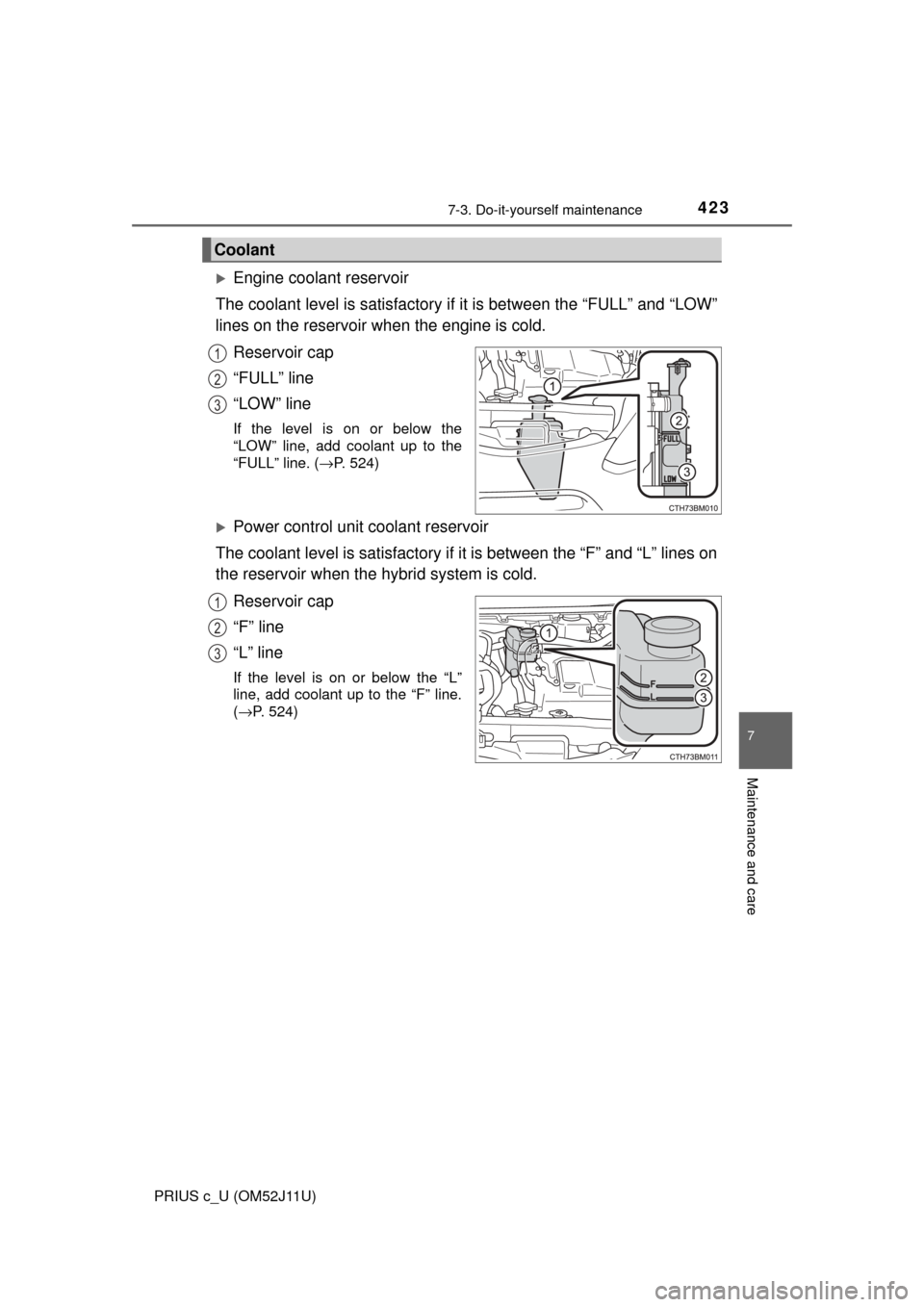
4237-3. Do-it-yourself maintenance
7
Maintenance and care
PRIUS c_U (OM52J11U)
Engine coolant reservoir
The coolant level is satisfactory if it is between the “FULL” and “LOW”
lines on the reservoir when the engine is cold.
Reservoir cap
“FULL” line
“LOW” line
If the level is on or below the
“LOW” line, add coolant up to the
“FULL” line. ( →P. 524)
Power control unit coolant reservoir
The coolant level is satisfactory if it is between the “F” and “L” lines on
the reservoir when the hybrid system is cold.
Reservoir cap
“F” line
“L” line
If the level is on or below the “L”
line, add coolant up to the “F” line.
(→P. 524)
Coolant
1
2
3
1
2
3
Page 424 of 596
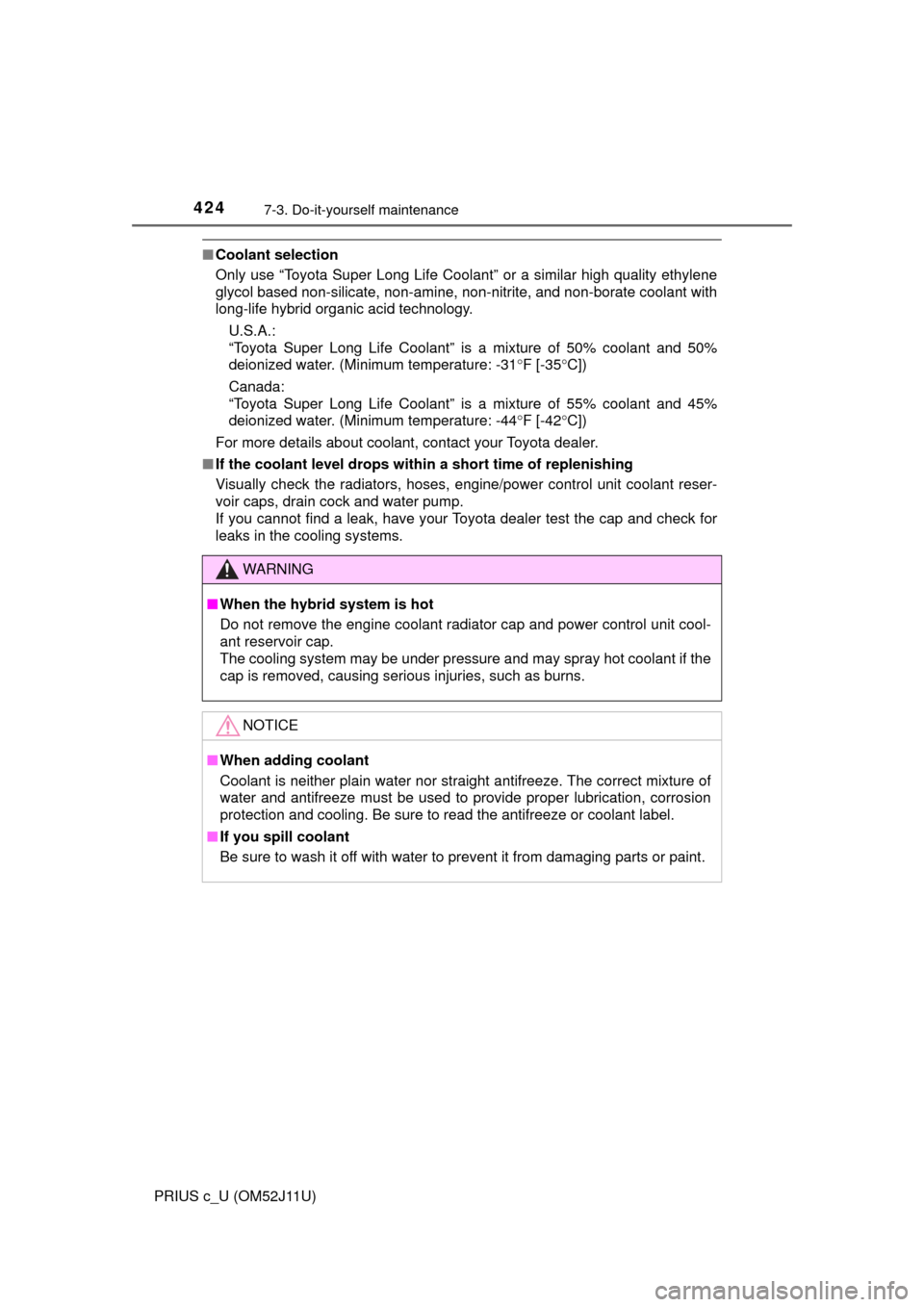
4247-3. Do-it-yourself maintenance
PRIUS c_U (OM52J11U)
■Coolant selection
Only use “Toyota Super Long Life Coolant” or a similar high quality ethylene
glycol based non-silicate, non-amine, non-nitrite, and non-borate coolant with
long-life hybrid organic acid technology.
U.S.A.:
“Toyota Super Long Life Coolant” is a mixture of 50% coolant and 50%
deionized water. (Minimum temperature: -31 °F [-35 °C])
Canada:
“Toyota Super Long Life Coolant” is a mixture of 55% coolant and 45%
deionized water. (Minimum temperature: -44 °F [-42 °C])
For more details about coolant, contact your Toyota dealer.
■ If the coolant level drops within a short time of replenishing
Visually check the radiators, hoses, engine/power control unit coolant reser-
voir caps, drain cock and water pump.
If you cannot find a leak, have your Toyota dealer test the cap and check for
leaks in the cooling systems.
WARNING
■When the hybrid system is hot
Do not remove the engine coolant radiator cap and power control unit cool-
ant reservoir cap.
The cooling system may be under pressure and may spray hot coolant if the
cap is removed, causing serious injuries, such as burns.
NOTICE
■When adding coolant
Coolant is neither plain water nor stra ight antifreeze. The correct mixture of
water and antifreeze must be used to provide proper lubrication, corrosion
protection and cooling. Be sure to read the antifreeze or coolant label.
■ If you spill coolant
Be sure to wash it off with water to prevent it from damaging parts or paint.
Page 425 of 596
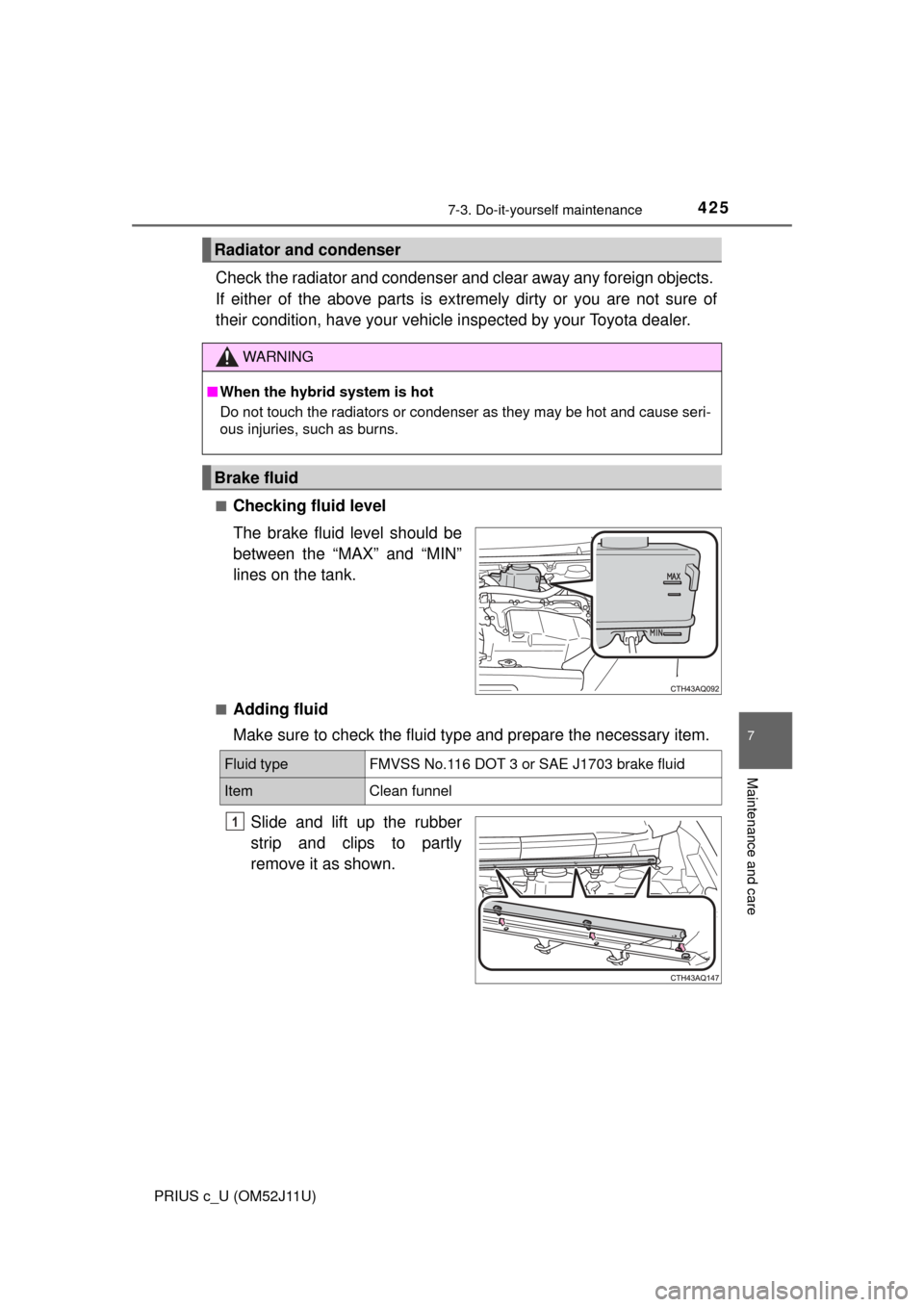
4257-3. Do-it-yourself maintenance
7
Maintenance and care
PRIUS c_U (OM52J11U)
Check the radiator and condenser and clear away any foreign objects.
If either of the above parts is ex tremely dirty or you are not sure of
their condition, have yo ur vehicle inspected by your Toyota dealer.
■Checking fluid level
The brake fluid level should be
between the “MAX” and “MIN”
lines on the tank.
■Adding fluid
Make sure to check the fluid ty pe and prepare the necessary item.
Slide and lift up the rubber
strip and clips to partly
remove it as shown.
Radiator and condenser
WARNING
■ When the hybrid system is hot
Do not touch the radiators or condenser as they may be hot and cause seri-
ous injuries, such as burns.
Brake fluid
Fluid type FMVSS No.116 DOT 3 or SAE J1703 brake fluid
Item Clean funnel
1
Page 426 of 596
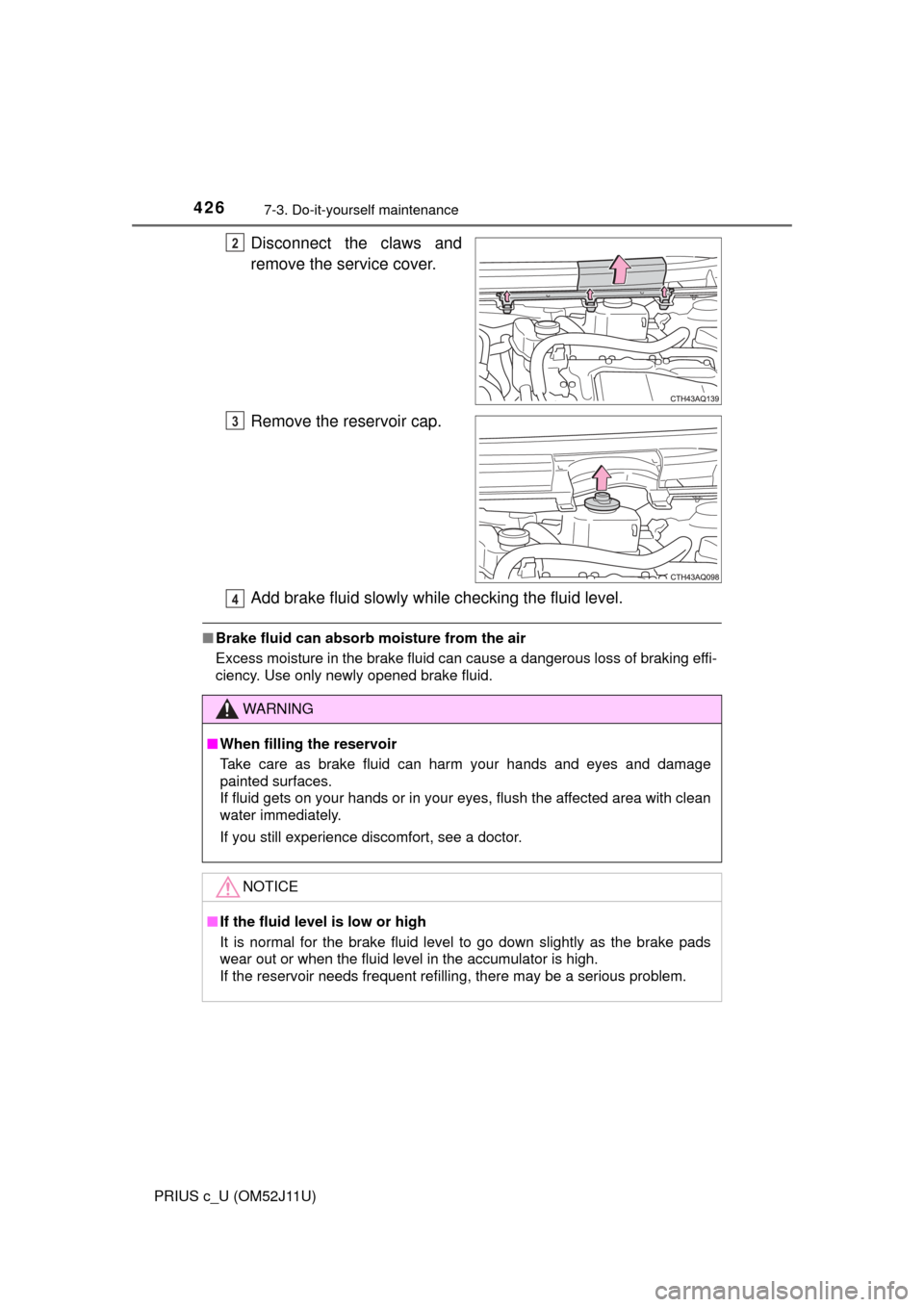
4267-3. Do-it-yourself maintenance
PRIUS c_U (OM52J11U)
Disconnect the claws and
remove the service cover.
Remove the reservoir cap.
Add brake fluid slowly while checking the fluid level.
■Brake fluid can absorb moisture from the air
Excess moisture in the brake fluid can cause a dangerous loss of braking effi-
ciency. Use only newly opened brake fluid.
2
3
WARNING
■When filling the reservoir
Take care as brake fluid can harm your hands and eyes and damage
painted surfaces.
If fluid gets on your hands or in your eyes, flush the affected area with clean
water immediately.
If you still experience discomfort, see a doctor.
NOTICE
■If the fluid level is low or high
It is normal for the brake fluid level to go down slightly as the brake pads
wear out or when the fluid level in the accumulator is high.
If the reservoir needs frequent refilling, there may be a serious problem.
4
Page 427 of 596
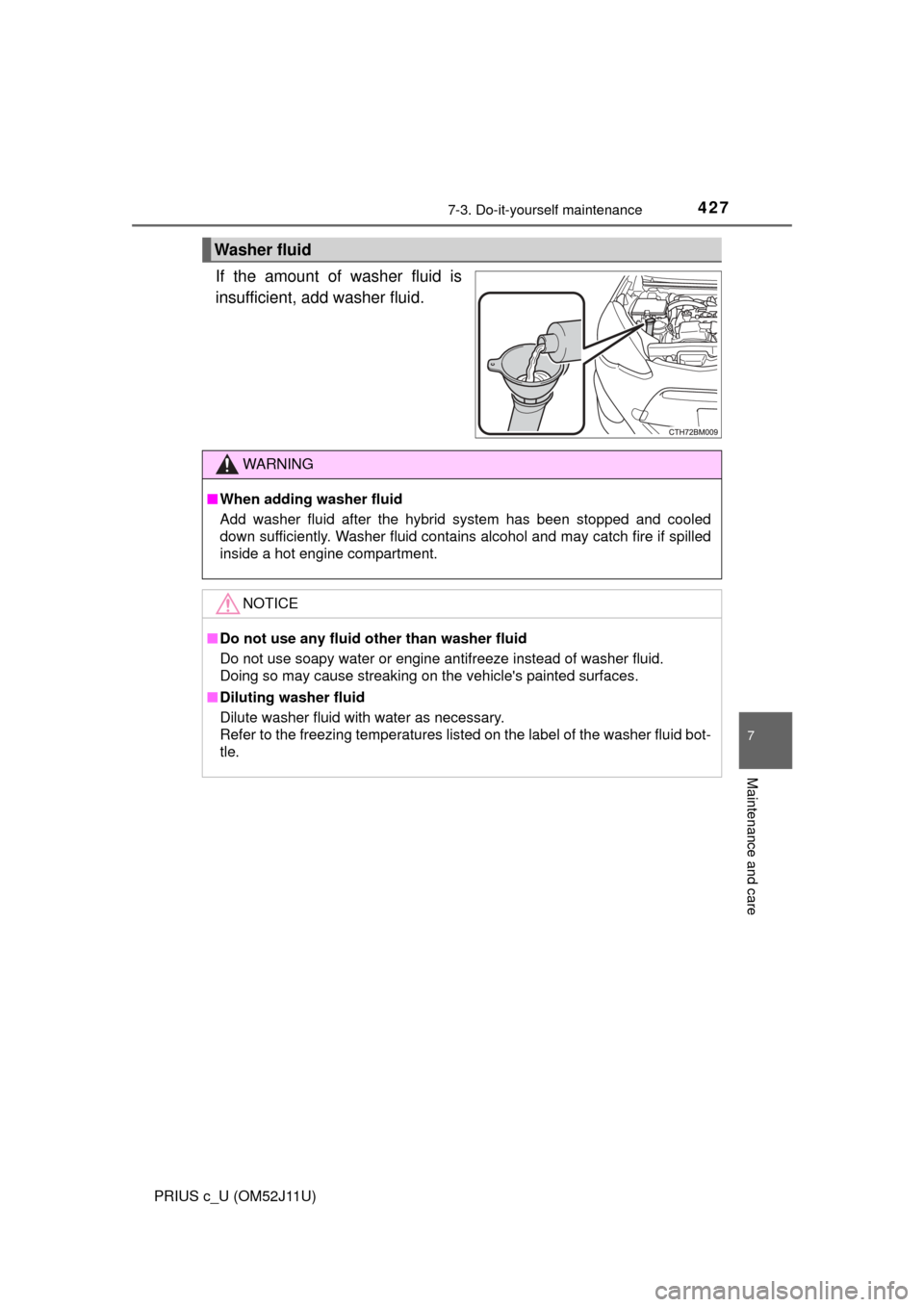
4277-3. Do-it-yourself maintenance
7
Maintenance and care
PRIUS c_U (OM52J11U)
If the amount of washer fluid is
insufficient, add washer fluid.
Washer fluid
WARNING
■When adding washer fluid
Add washer fluid after the hybrid system has been stopped and cooled
down sufficiently. Washer fluid contains alcohol and may catch fire if spilled
inside a hot engine compartment.
NOTICE
■Do not use any fluid other than washer fluid
Do not use soapy water or engine antifreeze instead of washer fluid.
Doing so may cause streaking on the vehicle's painted surfaces.
■ Diluting washer fluid
Dilute washer fluid with water as necessary.
Refer to the freezing temperatures listed on the label of the washer fluid bot-
tle.
Page 428 of 596
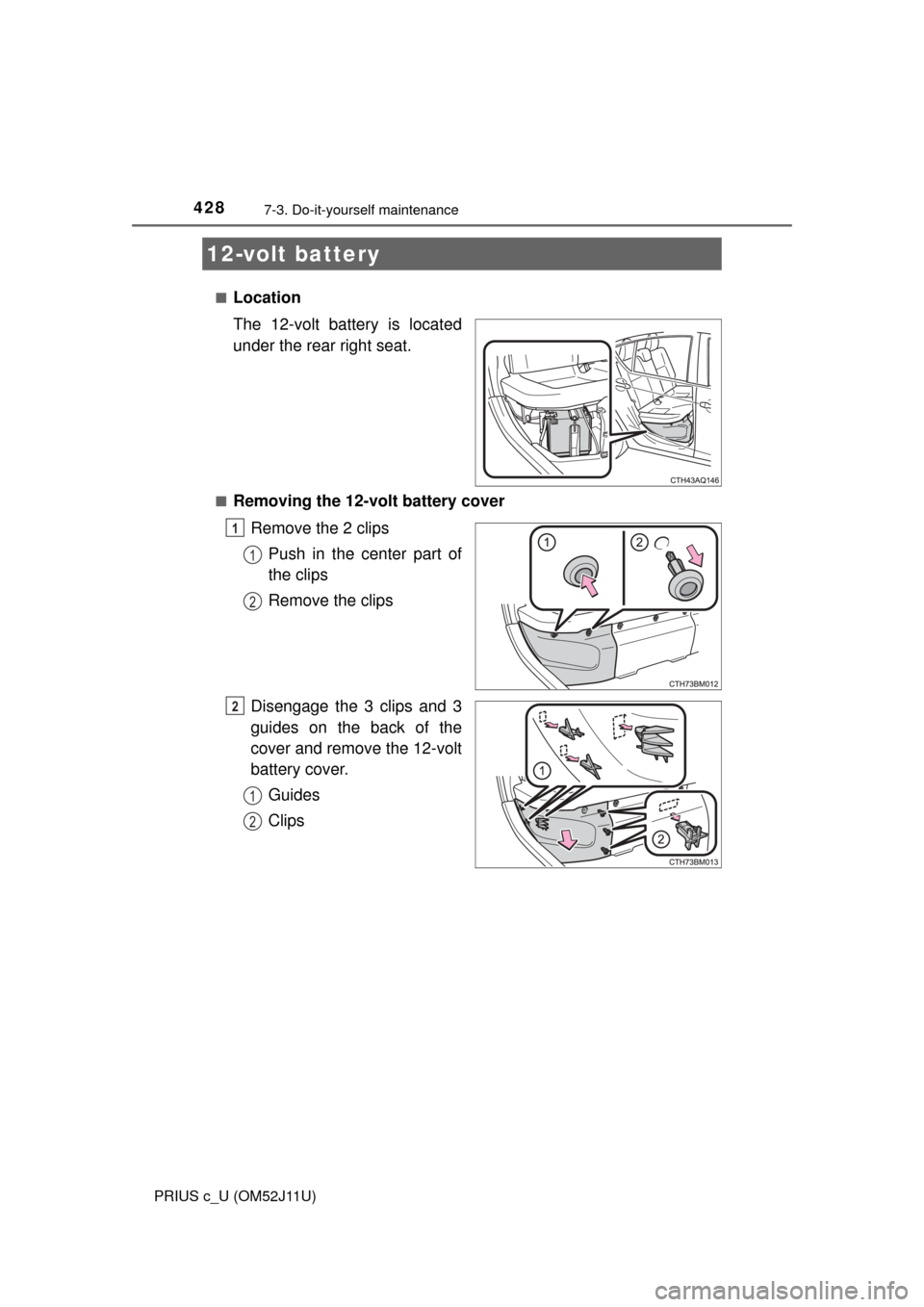
4287-3. Do-it-yourself maintenance
PRIUS c_U (OM52J11U)■
Location
The 12-volt battery is located
under the rear right seat.
■Removing the 12-volt battery cover
Remove the 2 clipsPush in the center part of
the clips
Remove the clips
Disengage the 3 clips and 3
guides on the back of the
cover and remove the 12-volt
battery cover. Guides
Clips
12-volt battery
1
1
2
2
1
2
Page 429 of 596
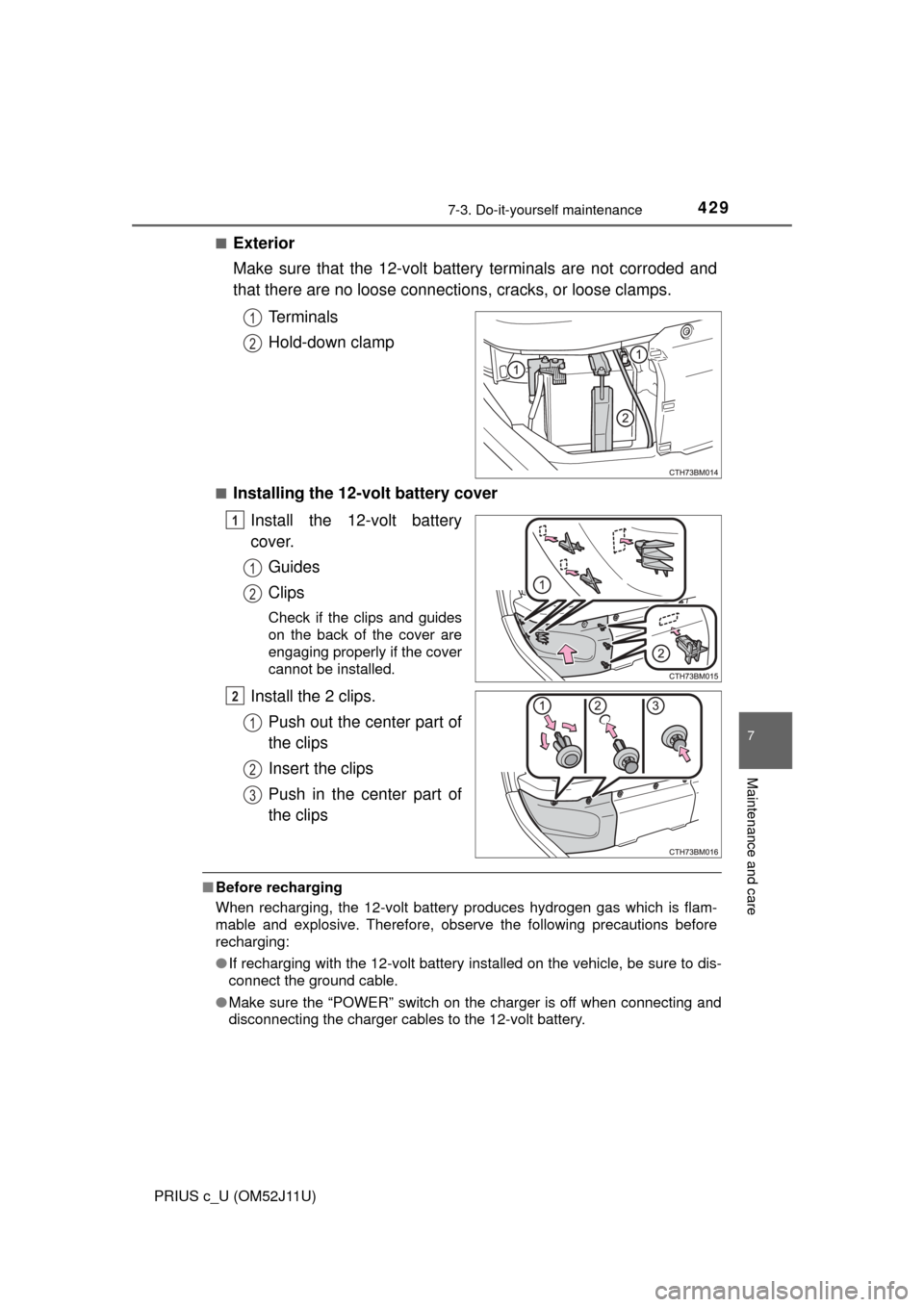
4297-3. Do-it-yourself maintenance
7
Maintenance and care
PRIUS c_U (OM52J11U)■
Exterior
Make sure that the 12-volt battery terminals are not corroded and
that there are no loose connecti
ons, cracks, or loose clamps.
Terminals
Hold-down clamp
■Installing the 12-volt battery cover Install the 12-volt battery
cover.Guides
Clips
Check if the clips and guides
on the back of the cover are
engaging properly if the cover
cannot be installed.
Install the 2 clips.Push out the center part of
the clips
Insert the clips
Push in the center part of
the clips
■Before recharging
When recharging, the 12-volt battery produces hydrogen gas which is flam-
mable and explosive. Therefore, observe the following precautions before
recharging:
●If recharging with the 12-volt battery installed on the vehicle, be sure to dis-
connect the ground cable.
● Make sure the “POWER” switch on the charger is off when connecting and
disconnecting the charger cables to the 12-volt battery.
1
2
1
1
2
2
1
2
3
Page 430 of 596
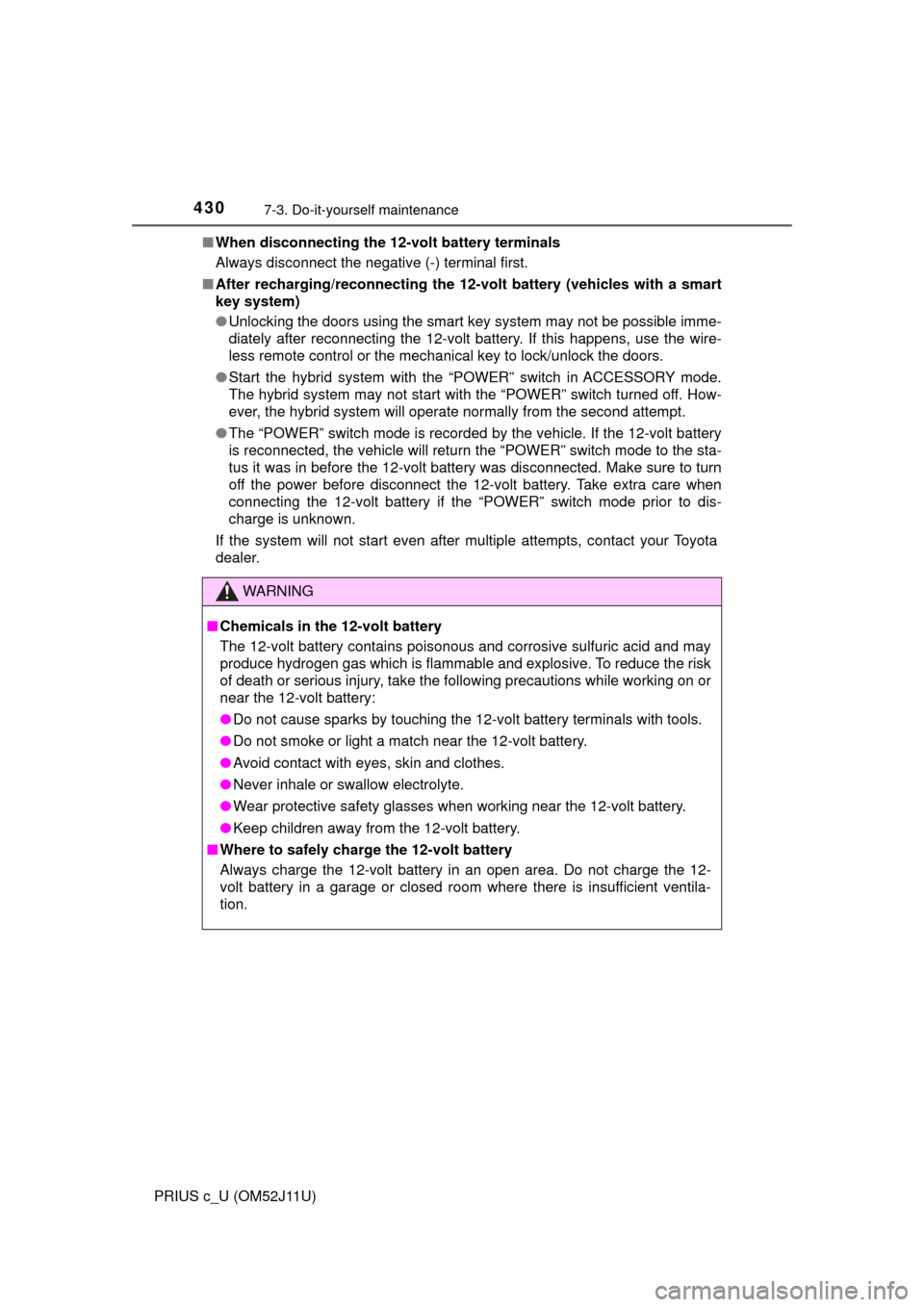
4307-3. Do-it-yourself maintenance
PRIUS c_U (OM52J11U)■
When disconnecting the 12- volt battery terminals
Always disconnect the negative (-) terminal first.
■ After recharging/reconnecting the 12-vo lt battery (vehicles with a smart
key system)
● Unlocking the doors using the smart key system may not be possible imme-
diately after reconnecting the 12-volt battery. If this happens, use the wire-
less remote control or the mechanical key to lock/unlock the doors.
● Start the hybrid system with the “POWER” switch in ACCESSORY mode.
The hybrid system may not start with the “POWER” switch turned off. How-
ever, the hybrid system will operat e normally from the second attempt.
● The “POWER” switch mode is recorded by the vehicle. If the 12-volt battery
is reconnected, the vehicle will return the “POWER” switch mode to the sta-
tus it was in before the 12-volt battery was disconnected. Make sure to turn
off the power before disconnect the 12-volt battery. Take extra care when
connecting the 12-volt battery if the “POWER” switch mode prior to dis-
charge is unknown.
If the system will not start even after multiple attempts, contact your Toyota
dealer.
WARNING
■ Chemicals in the 12-volt battery
The 12-volt battery contains poisonous and corrosive sulfuric acid and may
produce hydrogen gas which is flammable and explosive. To reduce the risk
of death or serious injury, take the following precautions while working on or
near the 12-volt battery:
● Do not cause sparks by touching the 12-volt battery terminals with tools.
● Do not smoke or light a match near the 12-volt battery.
● Avoid contact with eyes, skin and clothes.
● Never inhale or swallow electrolyte.
● Wear protective safety glasses when working near the 12-volt battery.
● Keep children away from the 12-volt battery.
■ Where to safely charge the 12-volt battery
Always charge the 12-volt battery in an open area. Do not charge the 12-
volt battery in a garage or closed room where there is insufficient ventila-
tion.